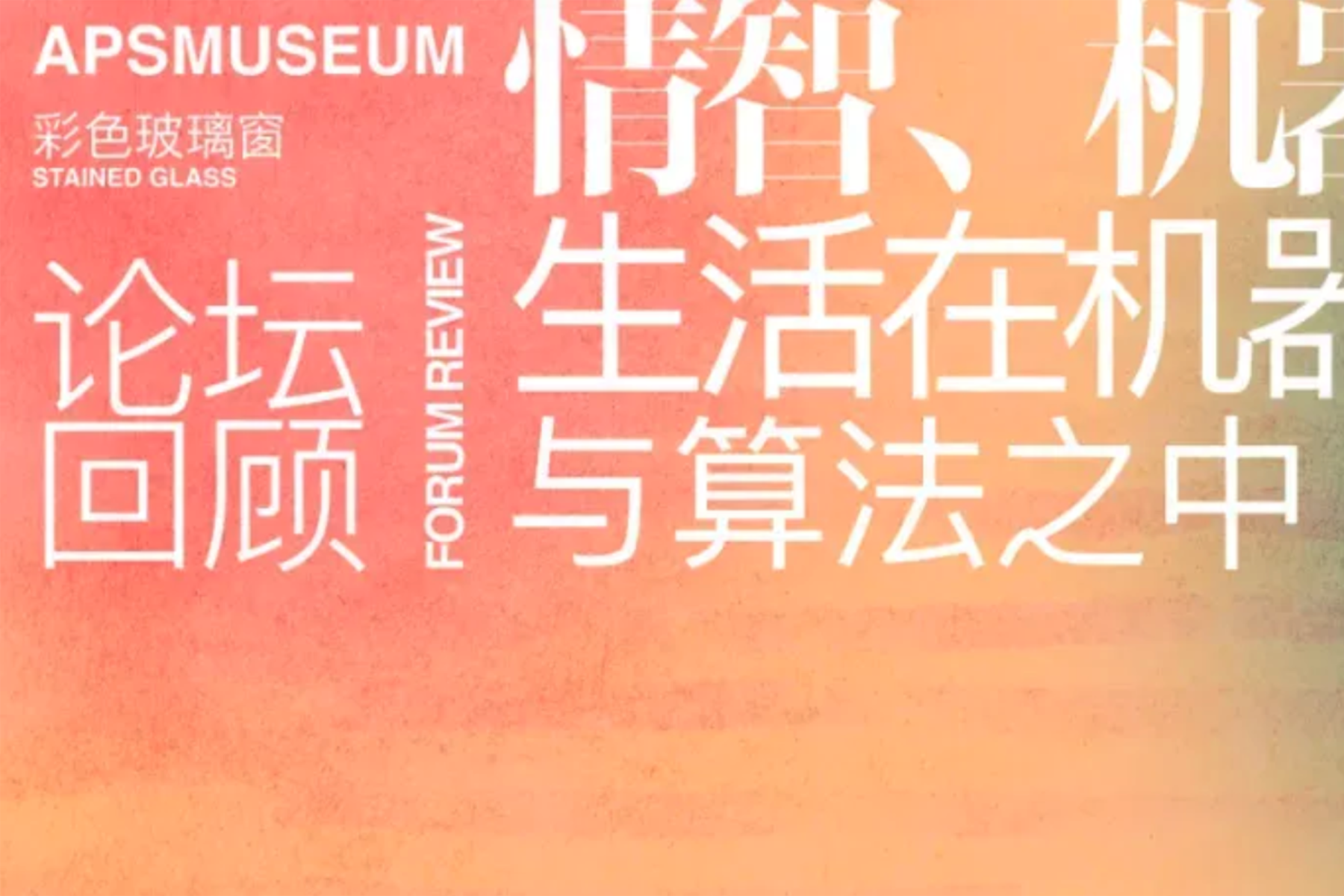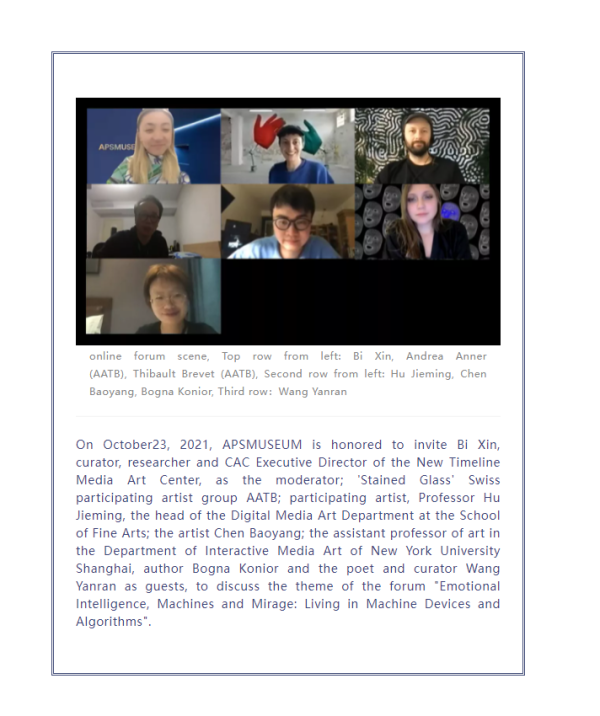
Mind, Machine, Mirage
Living Amongst Robotics and Algorithms
As the moderator of the forum, Bi Xin first invited the guests to give a speech on their own opinions of the theme, according to the works in the exhibition and their own researches. AATB showed the audience their representative works and corresponding research themes in their careers. Hu Jieming shared his thinking on the meaning of images and explained the ‘locality' and the creative method starting from the picture and image itself. Chen Baoyang explores the mode of human interaction with the machine under the recommendation algorithm based on his own works. Bogna Konior gradually proposes the possibility of a mechanical-centered thinking mode. Wang Yanran systematically explained the phenomenological structure of time-consciousness and the relationship between technology and memory. At the endof the forum, Bi Xin asked the guests about ‘the Future of Humans and Robots' and the concept of ‘meditation’ in the works of artist Hu Jieming, and the guests also responsed thoughtfully.
Below we have compiled the selected contents of the discussion by the host and six guests in the forum.
Swiss Artist group AATB showed their representative works and the corresponding research themes in their careers. Their early works explored the possibility of human manipulation of industrial robots in time and space, thereby adjusting the physical space into a programmable space. After that, AATB tried to overthrow the pursuit of productivity in the context of capitalism by putting robots in the daily context, letting them be clumsy and lazy, and explored the ‘inefficient output’ aspect of robots.
The works ‘Handshake’ and ‘Soap Opera’ in the show ‘Stained Glass’ explore the possibility of robots in time and space during the pandemic, explaining the concept of phenomenal pleasure and online presence ‘telepresence’. When human behavior is completed by non-humans, humans will turn their attention to the phenomenon itself. The work ‘Big Players’ further discusses their focus on the phenomenon. Two robotic arms shake the rope while people participate in rope skipping. The cooperation between humans and machines reveals the phenomenon of invisible connections between humans.

The artist Hu Jieming expressed his thoughts on the meaning of images from his ongoing work ‘Image Sentences’. This work uses pictorial information that spans hundreds of years, and when these information meet, the meaning of the familiar images are changed. Nearly a hundred years ago, Aby Warburg revealed the secrets of the image in his study ‘Mnemosyne atlas’, giving us a great revelation. Now when the ways of combining images in digital systems are becoming more and more abundant, the artist Hu Jieming tries to ‘make sentences’ of famous images spanning a century, and recreates ‘perceivable images' and ‘perceptible meanings’. The research for the new work ‘Image Sentences’ confirmed that the meaning of images is fluid, and the artist found that the meaning of the 'Image Sentences' in the timeline will quickly disappear, narrating a process of meaning consumption, where the meaning of the work lies in.
Then, the artist brought his thoughts back to the time he made works for the show ‘Stained Glass’ , expounding the working method of 'locality' and the consideration from the picture itself. Based on the APSMUSEUM site, the artist put environmental factors in the main position. The materials for all works are from L+MALL.
The works in the exhibition are divided into three parts, digital photography, video installations and algorithms to generate dynamic images. The digital photography part is created directly from the shooting in the mall. Photographic works are used as materials for image and algorithm creation. The outdoor video work ‘Meditation Someday’ interacts with dynamic images, shopping mall information and weather information.
Artist Chen Baoyang believes that ‘we are in the era of Information Cocoons and being wrapped in algorithms’. The first part of the AI car series was an AI car walking through a projection maze, and the second part was two AI cars chasing each other. In the work, the views of the cars were limited, and people could change the situation by interacting with the car in chasing. In this work, artist Chen Baoyang explored the human-based thinking mode of humans in the interaction with machines or algorithms under the recommendation algorithm.
Chen Baoyang‘s second work explored the relationship between humans and artificial intelligence by replacing one of the two faces in the movie plot, following the thinking of the former AI car series. Later, he mentioned a project in collaboration with scientists to generate calligraphy chapters through AI to further illustrate the relationship between human art and robots.
Finally, he mentioned that the work ‘Solar Protocol’ by artist Tega Brain overturned the general idea that digital technology is environmentally friendly, and reflected on the relationship between humans, machines, and the earth's environment through this work.
Bogna raised a question: when we face art and culture that can be automatically written by machines, can AI still maintain humanism in the process?
To illustrate, Bogna introduced a work independently created by AI that was auctioned by Christie‘s and was auctioned at a high price. When the entire history or art history of human beings can be analyzed or reorganized by AI to create, what will be the value of human creation? Focusing on the question of ‘whether AI will replace artists in creativity someday?’, Bogna believes that AI's artistic creation will not completely replace that of humanartists, because the objects they serve and the subjects in which the actions occur are completely different.
Humankind, as a collective group, may be used as a training material to train another species, like machines, to nurture their own new culture and new works. Under this imagination, human beings are no longer the center of cultural creation and historical writing. Instead, our behaviors will become a kind of nourishment to feed another species.
Wang Yanran first introduced the structure of time-consciousness. Husserl explained in ‘The Phenomenology of Internal Time-Consciousness’ that the first retention is perception, which means the experience of the living present; the second retention is the specific memory activity, which is the perception of the past. The process of recalling and imagining experience does not require technical support. Stigler invented the tertiary retention. Compared with the subjective activity of recall, tertiary retention is all forms of ‘objective’ memory. It is built on technology. Human beings need to rely on technology for self-preservation, and technology actually constitutes the essence of human beings.
However, if human beings rely too much on the tertiary retention, a memory crisis may occur. This increasingly standardized and externalized technical system will dominate our cognitive system. Stigler called this result the ‘proletarianization’ of universal cognition.
Xu Yu further invented the concept of tertiary protention as a supplement to the tertiary retention. He mentioned that the predictive function of the algorithm shows that the ‘tertiary protention’ of industrialization is very likely to deprive human beings of the imagination of the future. When imagination is limited by the expectations that algorithms provide us by collecting data and effective calculations, our lives are actually disciplinedby algorithms. This encoded memory will become a ‘negative memory’.